Essay: Assessing the Need for Business Process Visibility Framework
VerifiedAdded on 2020/10/22
|10
|2781
|459
Essay
AI Summary
This essay delves into the critical aspects of business process visibility within the framework of Business Process Management (BPM). It begins by defining BPM and the concept of process visibility, emphasizing the ability to view transactions and activities within a firm for enhanced transparency and operational responsiveness. The essay introduces a decision framework, the Process Visibility Fit Framework, designed to determine when technological investments are needed to enable real-time visibility. It explores the importance of process visibility, the technological capabilities required, and the application of the Process Visibility Fit Framework. The analysis incorporates the Information Processing View (IPV) as a theoretical foundation, examining factors such as task complexity, process interdependence, and strategic significance to assess visibility needs. The essay also discusses the impact of technological advancements like Business Activity Monitoring (BAM), Operational Business Intelligence (OpBI), and Business Process Intelligence (BPI) on the development of process visibility and the need for a fit between process visibility capabilities and requirements. The conclusion summarizes the importance of process visibility for effective business process management, emphasizing the role of the IPV framework in minimizing future uncertainty.

Business Process Management
Essay Review
Essay Review
Paraphrase This Document
Need a fresh take? Get an instant paraphrase of this document with our AI Paraphraser

Table of Contents
INTRODUCTION...........................................................................................................................1
MAIN BODY...................................................................................................................................1
CONCLUSION ...............................................................................................................................6
REFERENCES................................................................................................................................7
INTRODUCTION...........................................................................................................................1
MAIN BODY...................................................................................................................................1
CONCLUSION ...............................................................................................................................6
REFERENCES................................................................................................................................7
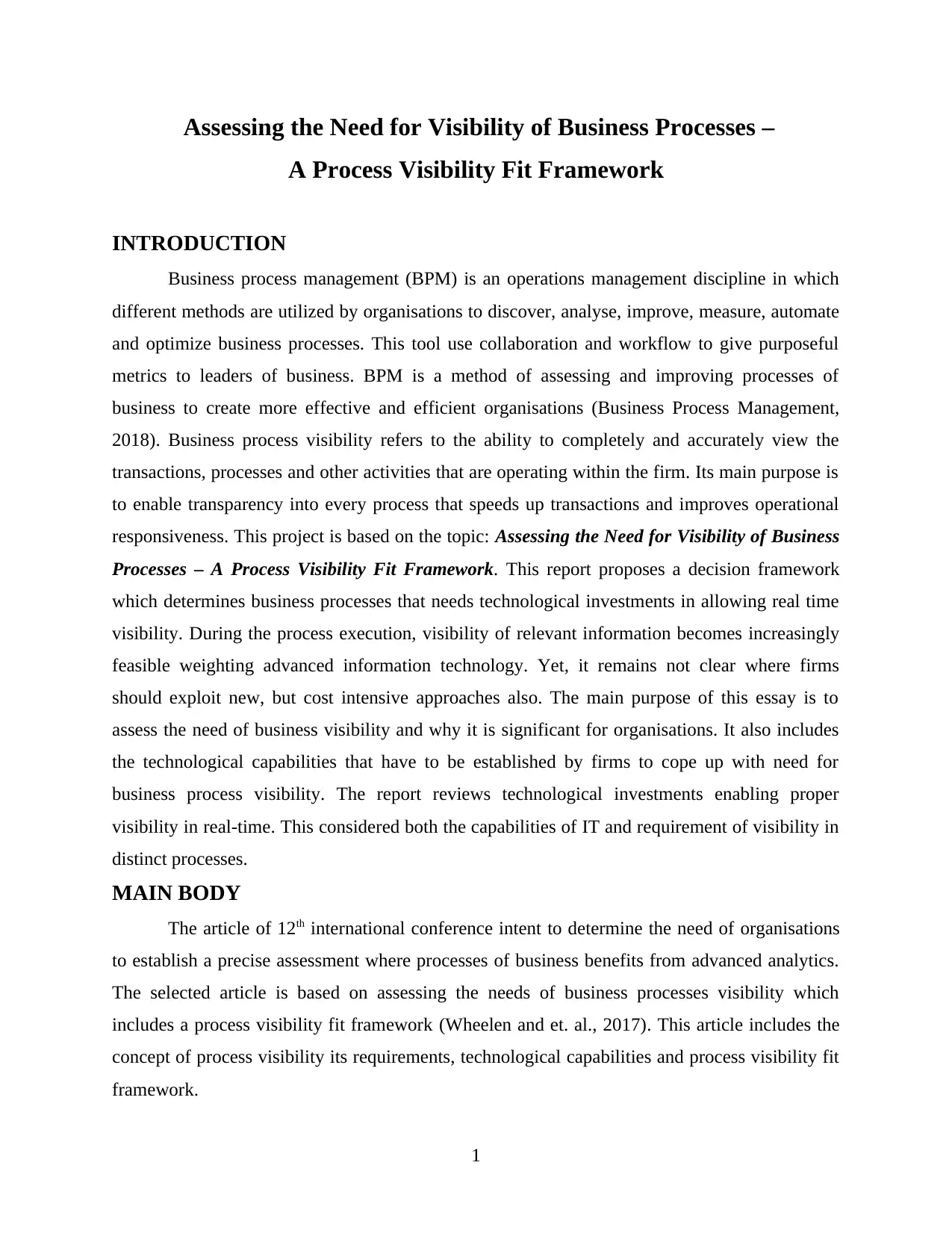
Assessing the Need for Visibility of Business Processes –
A Process Visibility Fit Framework
INTRODUCTION
Business process management (BPM) is an operations management discipline in which
different methods are utilized by organisations to discover, analyse, improve, measure, automate
and optimize business processes. This tool use collaboration and workflow to give purposeful
metrics to leaders of business. BPM is a method of assessing and improving processes of
business to create more effective and efficient organisations (Business Process Management,
2018). Business process visibility refers to the ability to completely and accurately view the
transactions, processes and other activities that are operating within the firm. Its main purpose is
to enable transparency into every process that speeds up transactions and improves operational
responsiveness. This project is based on the topic: Assessing the Need for Visibility of Business
Processes – A Process Visibility Fit Framework. This report proposes a decision framework
which determines business processes that needs technological investments in allowing real time
visibility. During the process execution, visibility of relevant information becomes increasingly
feasible weighting advanced information technology. Yet, it remains not clear where firms
should exploit new, but cost intensive approaches also. The main purpose of this essay is to
assess the need of business visibility and why it is significant for organisations. It also includes
the technological capabilities that have to be established by firms to cope up with need for
business process visibility. The report reviews technological investments enabling proper
visibility in real-time. This considered both the capabilities of IT and requirement of visibility in
distinct processes.
MAIN BODY
The article of 12th international conference intent to determine the need of organisations
to establish a precise assessment where processes of business benefits from advanced analytics.
The selected article is based on assessing the needs of business processes visibility which
includes a process visibility fit framework (Wheelen and et. al., 2017). This article includes the
concept of process visibility its requirements, technological capabilities and process visibility fit
framework.
1
A Process Visibility Fit Framework
INTRODUCTION
Business process management (BPM) is an operations management discipline in which
different methods are utilized by organisations to discover, analyse, improve, measure, automate
and optimize business processes. This tool use collaboration and workflow to give purposeful
metrics to leaders of business. BPM is a method of assessing and improving processes of
business to create more effective and efficient organisations (Business Process Management,
2018). Business process visibility refers to the ability to completely and accurately view the
transactions, processes and other activities that are operating within the firm. Its main purpose is
to enable transparency into every process that speeds up transactions and improves operational
responsiveness. This project is based on the topic: Assessing the Need for Visibility of Business
Processes – A Process Visibility Fit Framework. This report proposes a decision framework
which determines business processes that needs technological investments in allowing real time
visibility. During the process execution, visibility of relevant information becomes increasingly
feasible weighting advanced information technology. Yet, it remains not clear where firms
should exploit new, but cost intensive approaches also. The main purpose of this essay is to
assess the need of business visibility and why it is significant for organisations. It also includes
the technological capabilities that have to be established by firms to cope up with need for
business process visibility. The report reviews technological investments enabling proper
visibility in real-time. This considered both the capabilities of IT and requirement of visibility in
distinct processes.
MAIN BODY
The article of 12th international conference intent to determine the need of organisations
to establish a precise assessment where processes of business benefits from advanced analytics.
The selected article is based on assessing the needs of business processes visibility which
includes a process visibility fit framework (Wheelen and et. al., 2017). This article includes the
concept of process visibility its requirements, technological capabilities and process visibility fit
framework.
1
⊘ This is a preview!⊘
Do you want full access?
Subscribe today to unlock all pages.

Trusted by 1+ million students worldwide
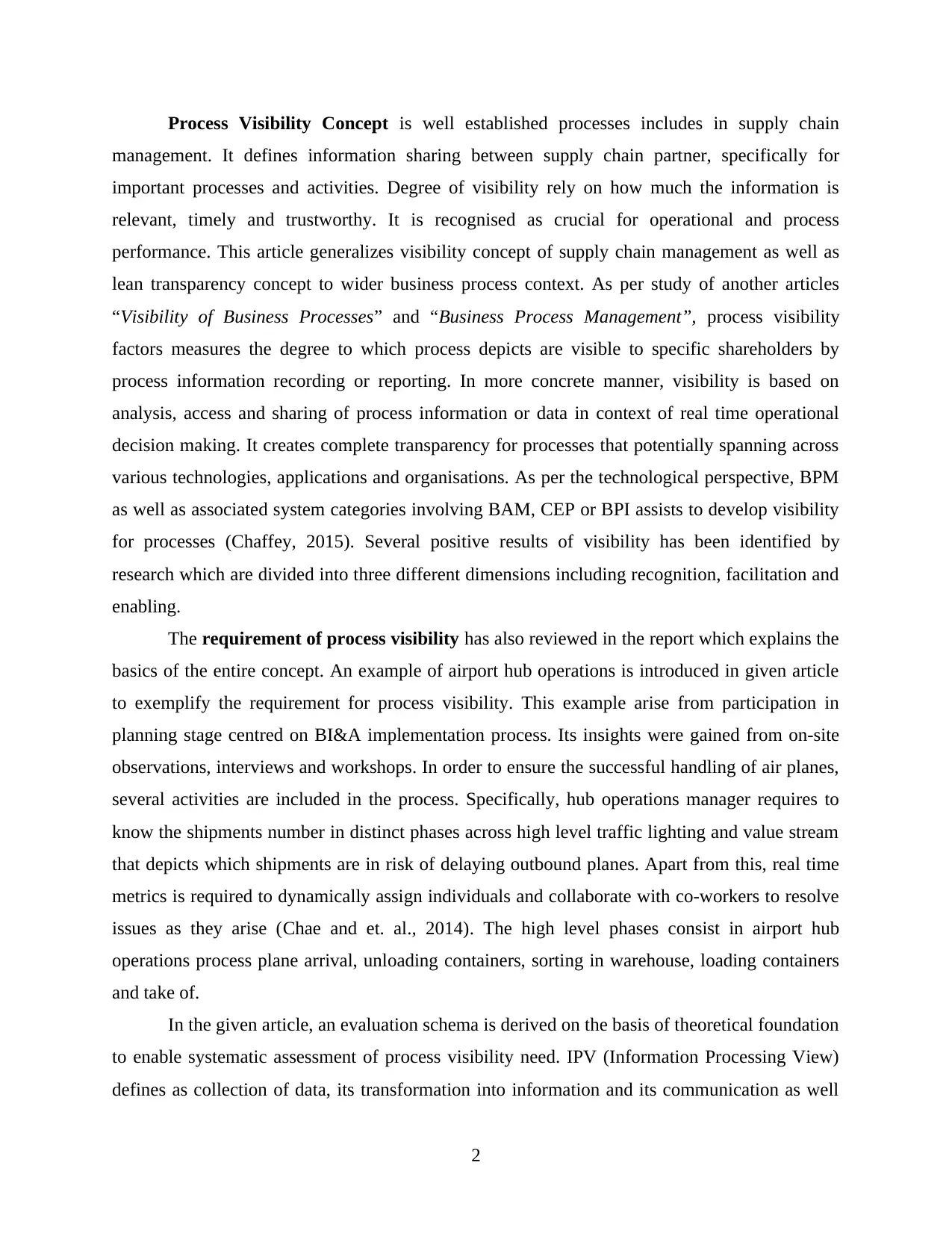
Process Visibility Concept is well established processes includes in supply chain
management. It defines information sharing between supply chain partner, specifically for
important processes and activities. Degree of visibility rely on how much the information is
relevant, timely and trustworthy. It is recognised as crucial for operational and process
performance. This article generalizes visibility concept of supply chain management as well as
lean transparency concept to wider business process context. As per study of another articles
“Visibility of Business Processes” and “Business Process Management”, process visibility
factors measures the degree to which process depicts are visible to specific shareholders by
process information recording or reporting. In more concrete manner, visibility is based on
analysis, access and sharing of process information or data in context of real time operational
decision making. It creates complete transparency for processes that potentially spanning across
various technologies, applications and organisations. As per the technological perspective, BPM
as well as associated system categories involving BAM, CEP or BPI assists to develop visibility
for processes (Chaffey, 2015). Several positive results of visibility has been identified by
research which are divided into three different dimensions including recognition, facilitation and
enabling.
The requirement of process visibility has also reviewed in the report which explains the
basics of the entire concept. An example of airport hub operations is introduced in given article
to exemplify the requirement for process visibility. This example arise from participation in
planning stage centred on BI&A implementation process. Its insights were gained from on-site
observations, interviews and workshops. In order to ensure the successful handling of air planes,
several activities are included in the process. Specifically, hub operations manager requires to
know the shipments number in distinct phases across high level traffic lighting and value stream
that depicts which shipments are in risk of delaying outbound planes. Apart from this, real time
metrics is required to dynamically assign individuals and collaborate with co-workers to resolve
issues as they arise (Chae and et. al., 2014). The high level phases consist in airport hub
operations process plane arrival, unloading containers, sorting in warehouse, loading containers
and take of.
In the given article, an evaluation schema is derived on the basis of theoretical foundation
to enable systematic assessment of process visibility need. IPV (Information Processing View)
defines as collection of data, its transformation into information and its communication as well
2
management. It defines information sharing between supply chain partner, specifically for
important processes and activities. Degree of visibility rely on how much the information is
relevant, timely and trustworthy. It is recognised as crucial for operational and process
performance. This article generalizes visibility concept of supply chain management as well as
lean transparency concept to wider business process context. As per study of another articles
“Visibility of Business Processes” and “Business Process Management”, process visibility
factors measures the degree to which process depicts are visible to specific shareholders by
process information recording or reporting. In more concrete manner, visibility is based on
analysis, access and sharing of process information or data in context of real time operational
decision making. It creates complete transparency for processes that potentially spanning across
various technologies, applications and organisations. As per the technological perspective, BPM
as well as associated system categories involving BAM, CEP or BPI assists to develop visibility
for processes (Chaffey, 2015). Several positive results of visibility has been identified by
research which are divided into three different dimensions including recognition, facilitation and
enabling.
The requirement of process visibility has also reviewed in the report which explains the
basics of the entire concept. An example of airport hub operations is introduced in given article
to exemplify the requirement for process visibility. This example arise from participation in
planning stage centred on BI&A implementation process. Its insights were gained from on-site
observations, interviews and workshops. In order to ensure the successful handling of air planes,
several activities are included in the process. Specifically, hub operations manager requires to
know the shipments number in distinct phases across high level traffic lighting and value stream
that depicts which shipments are in risk of delaying outbound planes. Apart from this, real time
metrics is required to dynamically assign individuals and collaborate with co-workers to resolve
issues as they arise (Chae and et. al., 2014). The high level phases consist in airport hub
operations process plane arrival, unloading containers, sorting in warehouse, loading containers
and take of.
In the given article, an evaluation schema is derived on the basis of theoretical foundation
to enable systematic assessment of process visibility need. IPV (Information Processing View)
defines as collection of data, its transformation into information and its communication as well
2
Paraphrase This Document
Need a fresh take? Get an instant paraphrase of this document with our AI Paraphraser
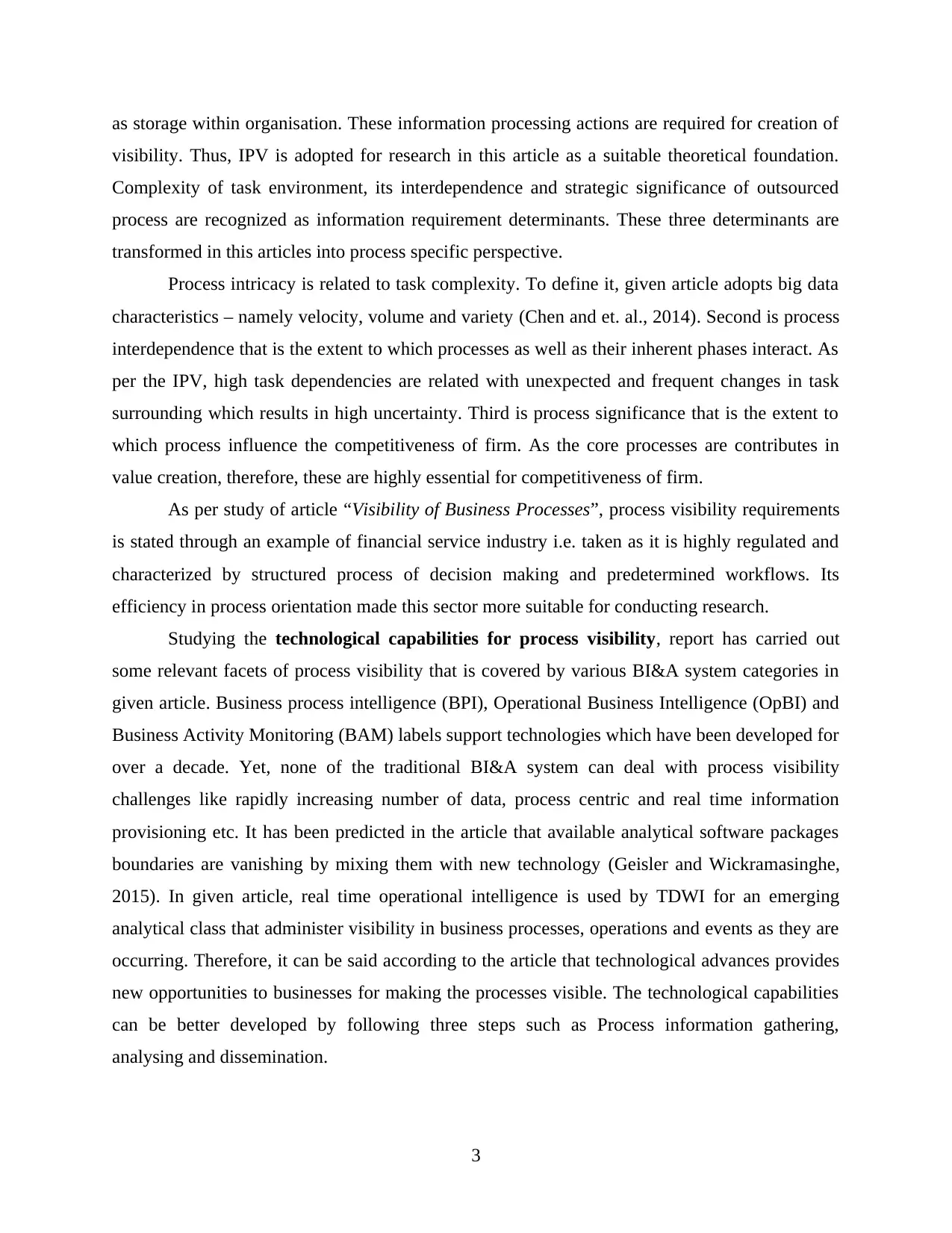
as storage within organisation. These information processing actions are required for creation of
visibility. Thus, IPV is adopted for research in this article as a suitable theoretical foundation.
Complexity of task environment, its interdependence and strategic significance of outsourced
process are recognized as information requirement determinants. These three determinants are
transformed in this articles into process specific perspective.
Process intricacy is related to task complexity. To define it, given article adopts big data
characteristics – namely velocity, volume and variety (Chen and et. al., 2014). Second is process
interdependence that is the extent to which processes as well as their inherent phases interact. As
per the IPV, high task dependencies are related with unexpected and frequent changes in task
surrounding which results in high uncertainty. Third is process significance that is the extent to
which process influence the competitiveness of firm. As the core processes are contributes in
value creation, therefore, these are highly essential for competitiveness of firm.
As per study of article “Visibility of Business Processes”, process visibility requirements
is stated through an example of financial service industry i.e. taken as it is highly regulated and
characterized by structured process of decision making and predetermined workflows. Its
efficiency in process orientation made this sector more suitable for conducting research.
Studying the technological capabilities for process visibility, report has carried out
some relevant facets of process visibility that is covered by various BI&A system categories in
given article. Business process intelligence (BPI), Operational Business Intelligence (OpBI) and
Business Activity Monitoring (BAM) labels support technologies which have been developed for
over a decade. Yet, none of the traditional BI&A system can deal with process visibility
challenges like rapidly increasing number of data, process centric and real time information
provisioning etc. It has been predicted in the article that available analytical software packages
boundaries are vanishing by mixing them with new technology (Geisler and Wickramasinghe,
2015). In given article, real time operational intelligence is used by TDWI for an emerging
analytical class that administer visibility in business processes, operations and events as they are
occurring. Therefore, it can be said according to the article that technological advances provides
new opportunities to businesses for making the processes visible. The technological capabilities
can be better developed by following three steps such as Process information gathering,
analysing and dissemination.
3
visibility. Thus, IPV is adopted for research in this article as a suitable theoretical foundation.
Complexity of task environment, its interdependence and strategic significance of outsourced
process are recognized as information requirement determinants. These three determinants are
transformed in this articles into process specific perspective.
Process intricacy is related to task complexity. To define it, given article adopts big data
characteristics – namely velocity, volume and variety (Chen and et. al., 2014). Second is process
interdependence that is the extent to which processes as well as their inherent phases interact. As
per the IPV, high task dependencies are related with unexpected and frequent changes in task
surrounding which results in high uncertainty. Third is process significance that is the extent to
which process influence the competitiveness of firm. As the core processes are contributes in
value creation, therefore, these are highly essential for competitiveness of firm.
As per study of article “Visibility of Business Processes”, process visibility requirements
is stated through an example of financial service industry i.e. taken as it is highly regulated and
characterized by structured process of decision making and predetermined workflows. Its
efficiency in process orientation made this sector more suitable for conducting research.
Studying the technological capabilities for process visibility, report has carried out
some relevant facets of process visibility that is covered by various BI&A system categories in
given article. Business process intelligence (BPI), Operational Business Intelligence (OpBI) and
Business Activity Monitoring (BAM) labels support technologies which have been developed for
over a decade. Yet, none of the traditional BI&A system can deal with process visibility
challenges like rapidly increasing number of data, process centric and real time information
provisioning etc. It has been predicted in the article that available analytical software packages
boundaries are vanishing by mixing them with new technology (Geisler and Wickramasinghe,
2015). In given article, real time operational intelligence is used by TDWI for an emerging
analytical class that administer visibility in business processes, operations and events as they are
occurring. Therefore, it can be said according to the article that technological advances provides
new opportunities to businesses for making the processes visible. The technological capabilities
can be better developed by following three steps such as Process information gathering,
analysing and dissemination.
3
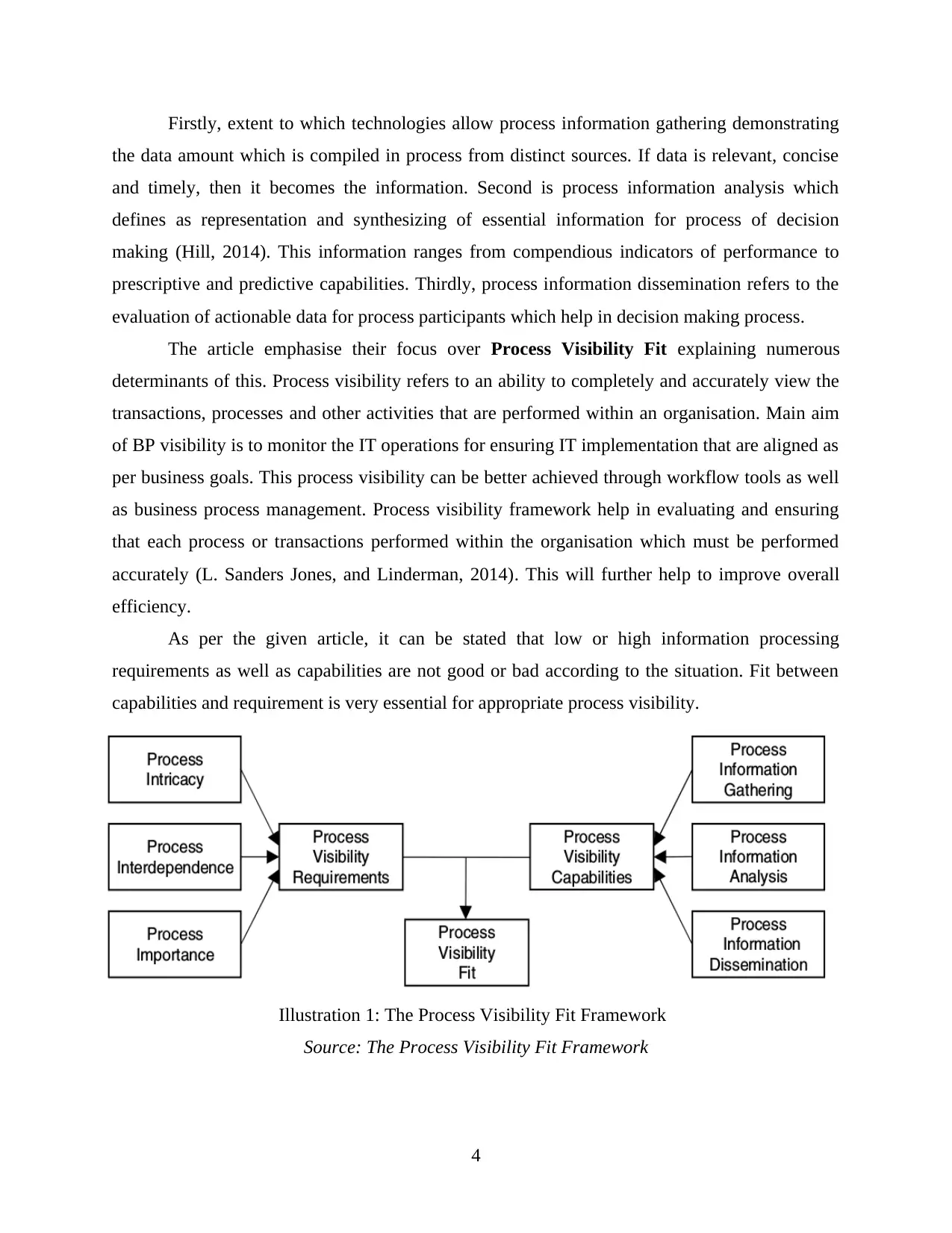
Firstly, extent to which technologies allow process information gathering demonstrating
the data amount which is compiled in process from distinct sources. If data is relevant, concise
and timely, then it becomes the information. Second is process information analysis which
defines as representation and synthesizing of essential information for process of decision
making (Hill, 2014). This information ranges from compendious indicators of performance to
prescriptive and predictive capabilities. Thirdly, process information dissemination refers to the
evaluation of actionable data for process participants which help in decision making process.
The article emphasise their focus over Process Visibility Fit explaining numerous
determinants of this. Process visibility refers to an ability to completely and accurately view the
transactions, processes and other activities that are performed within an organisation. Main aim
of BP visibility is to monitor the IT operations for ensuring IT implementation that are aligned as
per business goals. This process visibility can be better achieved through workflow tools as well
as business process management. Process visibility framework help in evaluating and ensuring
that each process or transactions performed within the organisation which must be performed
accurately (L. Sanders Jones, and Linderman, 2014). This will further help to improve overall
efficiency.
As per the given article, it can be stated that low or high information processing
requirements as well as capabilities are not good or bad according to the situation. Fit between
capabilities and requirement is very essential for appropriate process visibility.
Source: The Process Visibility Fit Framework
4
Illustration 1: The Process Visibility Fit Framework
the data amount which is compiled in process from distinct sources. If data is relevant, concise
and timely, then it becomes the information. Second is process information analysis which
defines as representation and synthesizing of essential information for process of decision
making (Hill, 2014). This information ranges from compendious indicators of performance to
prescriptive and predictive capabilities. Thirdly, process information dissemination refers to the
evaluation of actionable data for process participants which help in decision making process.
The article emphasise their focus over Process Visibility Fit explaining numerous
determinants of this. Process visibility refers to an ability to completely and accurately view the
transactions, processes and other activities that are performed within an organisation. Main aim
of BP visibility is to monitor the IT operations for ensuring IT implementation that are aligned as
per business goals. This process visibility can be better achieved through workflow tools as well
as business process management. Process visibility framework help in evaluating and ensuring
that each process or transactions performed within the organisation which must be performed
accurately (L. Sanders Jones, and Linderman, 2014). This will further help to improve overall
efficiency.
As per the given article, it can be stated that low or high information processing
requirements as well as capabilities are not good or bad according to the situation. Fit between
capabilities and requirement is very essential for appropriate process visibility.
Source: The Process Visibility Fit Framework
4
Illustration 1: The Process Visibility Fit Framework
⊘ This is a preview!⊘
Do you want full access?
Subscribe today to unlock all pages.

Trusted by 1+ million students worldwide
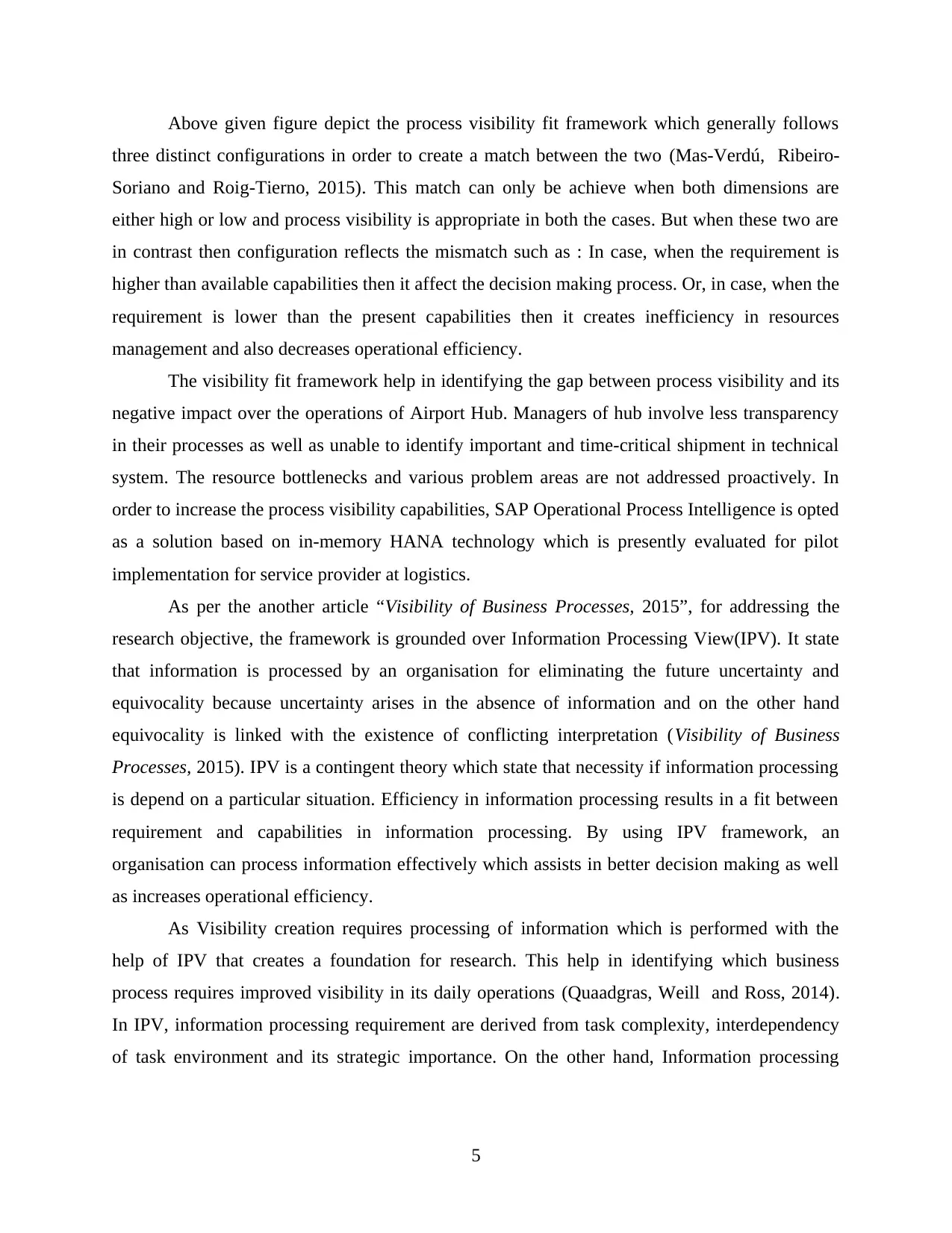
Above given figure depict the process visibility fit framework which generally follows
three distinct configurations in order to create a match between the two (Mas-Verdú, Ribeiro-
Soriano and Roig-Tierno, 2015). This match can only be achieve when both dimensions are
either high or low and process visibility is appropriate in both the cases. But when these two are
in contrast then configuration reflects the mismatch such as : In case, when the requirement is
higher than available capabilities then it affect the decision making process. Or, in case, when the
requirement is lower than the present capabilities then it creates inefficiency in resources
management and also decreases operational efficiency.
The visibility fit framework help in identifying the gap between process visibility and its
negative impact over the operations of Airport Hub. Managers of hub involve less transparency
in their processes as well as unable to identify important and time-critical shipment in technical
system. The resource bottlenecks and various problem areas are not addressed proactively. In
order to increase the process visibility capabilities, SAP Operational Process Intelligence is opted
as a solution based on in-memory HANA technology which is presently evaluated for pilot
implementation for service provider at logistics.
As per the another article “Visibility of Business Processes, 2015”, for addressing the
research objective, the framework is grounded over Information Processing View(IPV). It state
that information is processed by an organisation for eliminating the future uncertainty and
equivocality because uncertainty arises in the absence of information and on the other hand
equivocality is linked with the existence of conflicting interpretation (Visibility of Business
Processes, 2015). IPV is a contingent theory which state that necessity if information processing
is depend on a particular situation. Efficiency in information processing results in a fit between
requirement and capabilities in information processing. By using IPV framework, an
organisation can process information effectively which assists in better decision making as well
as increases operational efficiency.
As Visibility creation requires processing of information which is performed with the
help of IPV that creates a foundation for research. This help in identifying which business
process requires improved visibility in its daily operations (Quaadgras, Weill and Ross, 2014).
In IPV, information processing requirement are derived from task complexity, interdependency
of task environment and its strategic importance. On the other hand, Information processing
5
three distinct configurations in order to create a match between the two (Mas-Verdú, Ribeiro-
Soriano and Roig-Tierno, 2015). This match can only be achieve when both dimensions are
either high or low and process visibility is appropriate in both the cases. But when these two are
in contrast then configuration reflects the mismatch such as : In case, when the requirement is
higher than available capabilities then it affect the decision making process. Or, in case, when the
requirement is lower than the present capabilities then it creates inefficiency in resources
management and also decreases operational efficiency.
The visibility fit framework help in identifying the gap between process visibility and its
negative impact over the operations of Airport Hub. Managers of hub involve less transparency
in their processes as well as unable to identify important and time-critical shipment in technical
system. The resource bottlenecks and various problem areas are not addressed proactively. In
order to increase the process visibility capabilities, SAP Operational Process Intelligence is opted
as a solution based on in-memory HANA technology which is presently evaluated for pilot
implementation for service provider at logistics.
As per the another article “Visibility of Business Processes, 2015”, for addressing the
research objective, the framework is grounded over Information Processing View(IPV). It state
that information is processed by an organisation for eliminating the future uncertainty and
equivocality because uncertainty arises in the absence of information and on the other hand
equivocality is linked with the existence of conflicting interpretation (Visibility of Business
Processes, 2015). IPV is a contingent theory which state that necessity if information processing
is depend on a particular situation. Efficiency in information processing results in a fit between
requirement and capabilities in information processing. By using IPV framework, an
organisation can process information effectively which assists in better decision making as well
as increases operational efficiency.
As Visibility creation requires processing of information which is performed with the
help of IPV that creates a foundation for research. This help in identifying which business
process requires improved visibility in its daily operations (Quaadgras, Weill and Ross, 2014).
In IPV, information processing requirement are derived from task complexity, interdependency
of task environment and its strategic importance. On the other hand, Information processing
5
Paraphrase This Document
Need a fresh take? Get an instant paraphrase of this document with our AI Paraphraser
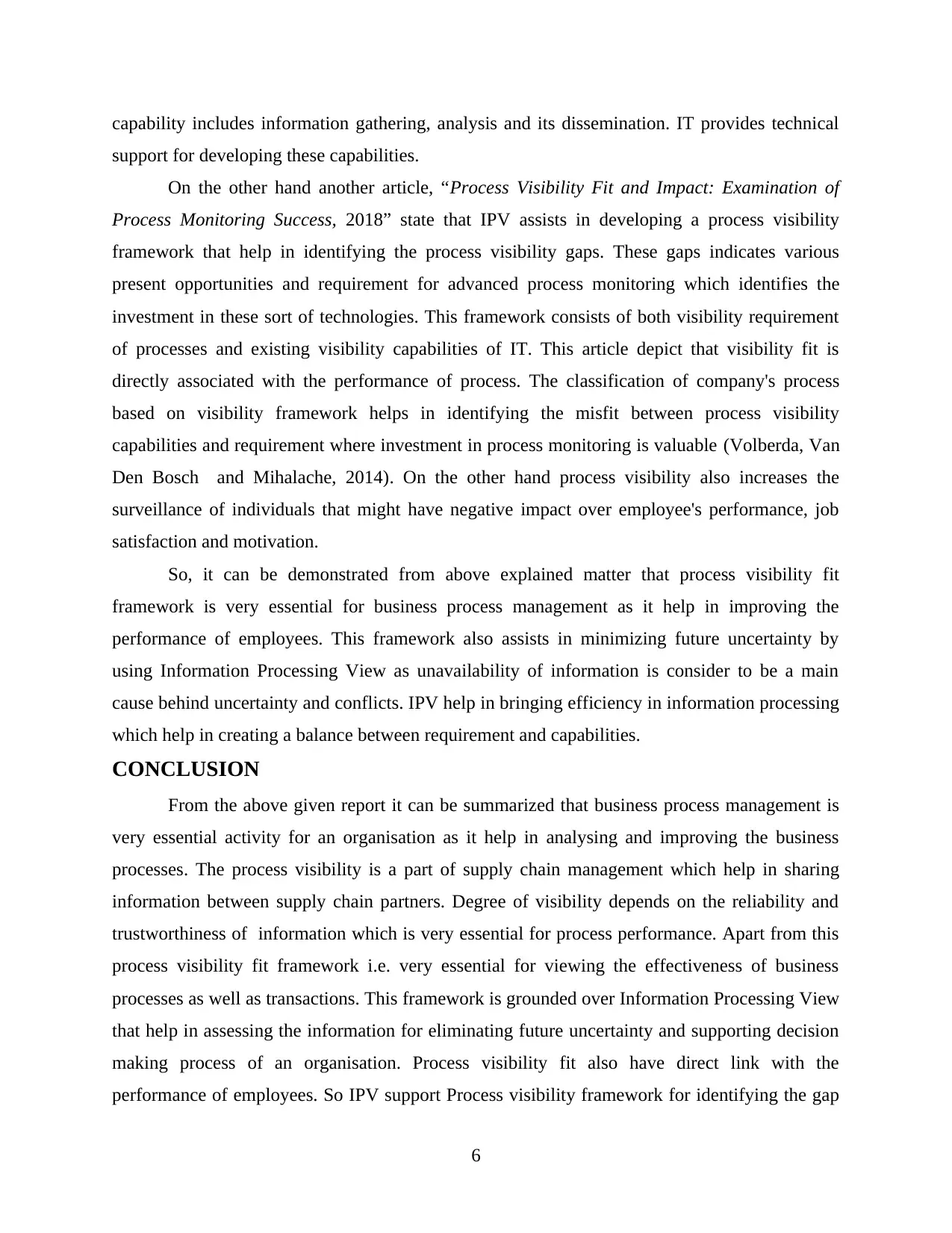
capability includes information gathering, analysis and its dissemination. IT provides technical
support for developing these capabilities.
On the other hand another article, “Process Visibility Fit and Impact: Examination of
Process Monitoring Success, 2018” state that IPV assists in developing a process visibility
framework that help in identifying the process visibility gaps. These gaps indicates various
present opportunities and requirement for advanced process monitoring which identifies the
investment in these sort of technologies. This framework consists of both visibility requirement
of processes and existing visibility capabilities of IT. This article depict that visibility fit is
directly associated with the performance of process. The classification of company's process
based on visibility framework helps in identifying the misfit between process visibility
capabilities and requirement where investment in process monitoring is valuable (Volberda, Van
Den Bosch and Mihalache, 2014). On the other hand process visibility also increases the
surveillance of individuals that might have negative impact over employee's performance, job
satisfaction and motivation.
So, it can be demonstrated from above explained matter that process visibility fit
framework is very essential for business process management as it help in improving the
performance of employees. This framework also assists in minimizing future uncertainty by
using Information Processing View as unavailability of information is consider to be a main
cause behind uncertainty and conflicts. IPV help in bringing efficiency in information processing
which help in creating a balance between requirement and capabilities.
CONCLUSION
From the above given report it can be summarized that business process management is
very essential activity for an organisation as it help in analysing and improving the business
processes. The process visibility is a part of supply chain management which help in sharing
information between supply chain partners. Degree of visibility depends on the reliability and
trustworthiness of information which is very essential for process performance. Apart from this
process visibility fit framework i.e. very essential for viewing the effectiveness of business
processes as well as transactions. This framework is grounded over Information Processing View
that help in assessing the information for eliminating future uncertainty and supporting decision
making process of an organisation. Process visibility fit also have direct link with the
performance of employees. So IPV support Process visibility framework for identifying the gap
6
support for developing these capabilities.
On the other hand another article, “Process Visibility Fit and Impact: Examination of
Process Monitoring Success, 2018” state that IPV assists in developing a process visibility
framework that help in identifying the process visibility gaps. These gaps indicates various
present opportunities and requirement for advanced process monitoring which identifies the
investment in these sort of technologies. This framework consists of both visibility requirement
of processes and existing visibility capabilities of IT. This article depict that visibility fit is
directly associated with the performance of process. The classification of company's process
based on visibility framework helps in identifying the misfit between process visibility
capabilities and requirement where investment in process monitoring is valuable (Volberda, Van
Den Bosch and Mihalache, 2014). On the other hand process visibility also increases the
surveillance of individuals that might have negative impact over employee's performance, job
satisfaction and motivation.
So, it can be demonstrated from above explained matter that process visibility fit
framework is very essential for business process management as it help in improving the
performance of employees. This framework also assists in minimizing future uncertainty by
using Information Processing View as unavailability of information is consider to be a main
cause behind uncertainty and conflicts. IPV help in bringing efficiency in information processing
which help in creating a balance between requirement and capabilities.
CONCLUSION
From the above given report it can be summarized that business process management is
very essential activity for an organisation as it help in analysing and improving the business
processes. The process visibility is a part of supply chain management which help in sharing
information between supply chain partners. Degree of visibility depends on the reliability and
trustworthiness of information which is very essential for process performance. Apart from this
process visibility fit framework i.e. very essential for viewing the effectiveness of business
processes as well as transactions. This framework is grounded over Information Processing View
that help in assessing the information for eliminating future uncertainty and supporting decision
making process of an organisation. Process visibility fit also have direct link with the
performance of employees. So IPV support Process visibility framework for identifying the gap
6

between processes and various measures to balance the information requirement with
capabilities.
7
capabilities.
7
⊘ This is a preview!⊘
Do you want full access?
Subscribe today to unlock all pages.

Trusted by 1+ million students worldwide
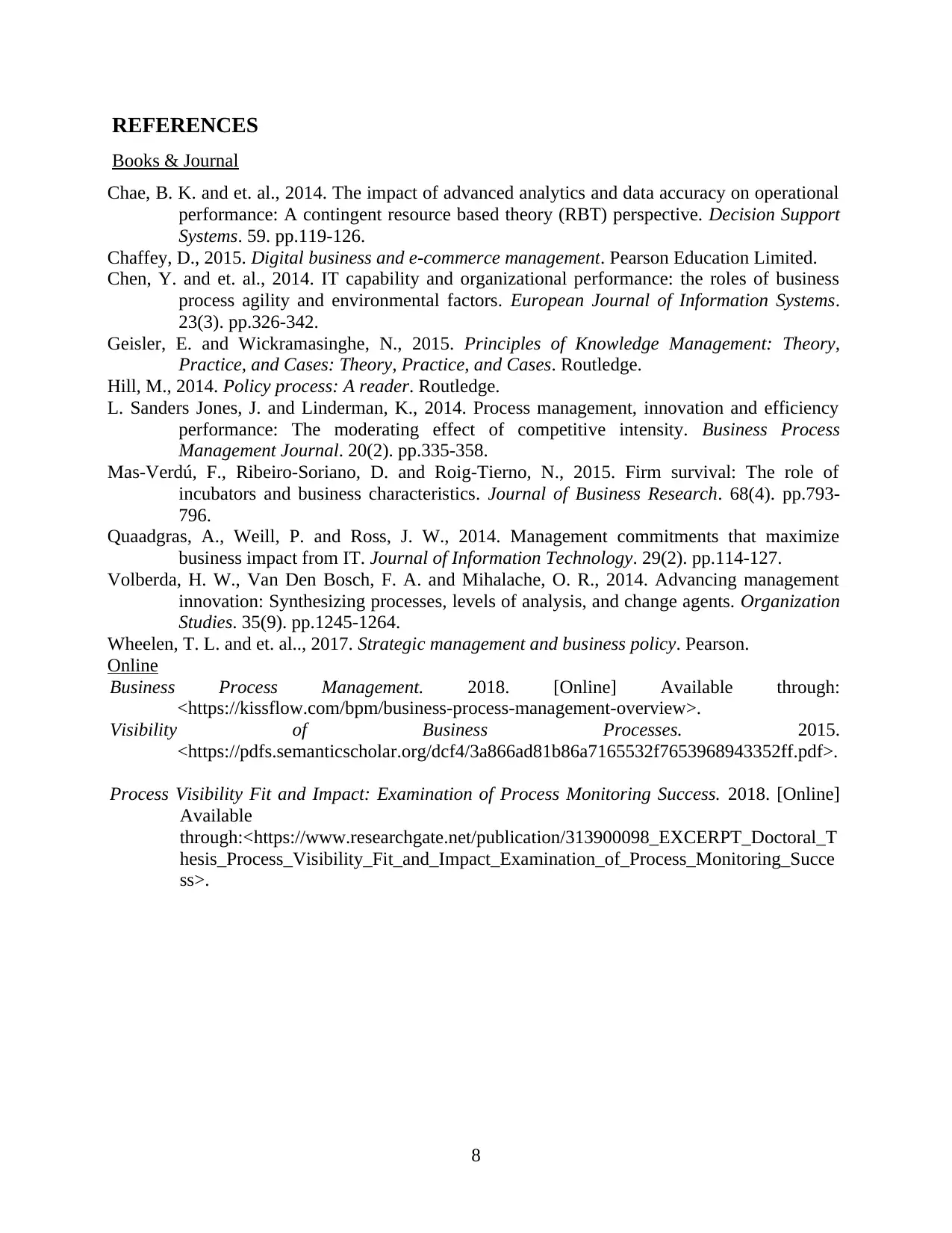
REFERENCES
Books & Journal
Chae, B. K. and et. al., 2014. The impact of advanced analytics and data accuracy on operational
performance: A contingent resource based theory (RBT) perspective. Decision Support
Systems. 59. pp.119-126.
Chaffey, D., 2015. Digital business and e-commerce management. Pearson Education Limited.
Chen, Y. and et. al., 2014. IT capability and organizational performance: the roles of business
process agility and environmental factors. European Journal of Information Systems.
23(3). pp.326-342.
Geisler, E. and Wickramasinghe, N., 2015. Principles of Knowledge Management: Theory,
Practice, and Cases: Theory, Practice, and Cases. Routledge.
Hill, M., 2014. Policy process: A reader. Routledge.
L. Sanders Jones, J. and Linderman, K., 2014. Process management, innovation and efficiency
performance: The moderating effect of competitive intensity. Business Process
Management Journal. 20(2). pp.335-358.
Mas-Verdú, F., Ribeiro-Soriano, D. and Roig-Tierno, N., 2015. Firm survival: The role of
incubators and business characteristics. Journal of Business Research. 68(4). pp.793-
796.
Quaadgras, A., Weill, P. and Ross, J. W., 2014. Management commitments that maximize
business impact from IT. Journal of Information Technology. 29(2). pp.114-127.
Volberda, H. W., Van Den Bosch, F. A. and Mihalache, O. R., 2014. Advancing management
innovation: Synthesizing processes, levels of analysis, and change agents. Organization
Studies. 35(9). pp.1245-1264.
Wheelen, T. L. and et. al.., 2017. Strategic management and business policy. Pearson.
Online
Business Process Management. 2018. [Online] Available through:
<https://kissflow.com/bpm/business-process-management-overview>.
Visibility of Business Processes. 2015.
<https://pdfs.semanticscholar.org/dcf4/3a866ad81b86a7165532f7653968943352ff.pdf>.
Process Visibility Fit and Impact: Examination of Process Monitoring Success. 2018. [Online]
Available
through:<https://www.researchgate.net/publication/313900098_EXCERPT_Doctoral_T
hesis_Process_Visibility_Fit_and_Impact_Examination_of_Process_Monitoring_Succe
ss>.
8
Books & Journal
Chae, B. K. and et. al., 2014. The impact of advanced analytics and data accuracy on operational
performance: A contingent resource based theory (RBT) perspective. Decision Support
Systems. 59. pp.119-126.
Chaffey, D., 2015. Digital business and e-commerce management. Pearson Education Limited.
Chen, Y. and et. al., 2014. IT capability and organizational performance: the roles of business
process agility and environmental factors. European Journal of Information Systems.
23(3). pp.326-342.
Geisler, E. and Wickramasinghe, N., 2015. Principles of Knowledge Management: Theory,
Practice, and Cases: Theory, Practice, and Cases. Routledge.
Hill, M., 2014. Policy process: A reader. Routledge.
L. Sanders Jones, J. and Linderman, K., 2014. Process management, innovation and efficiency
performance: The moderating effect of competitive intensity. Business Process
Management Journal. 20(2). pp.335-358.
Mas-Verdú, F., Ribeiro-Soriano, D. and Roig-Tierno, N., 2015. Firm survival: The role of
incubators and business characteristics. Journal of Business Research. 68(4). pp.793-
796.
Quaadgras, A., Weill, P. and Ross, J. W., 2014. Management commitments that maximize
business impact from IT. Journal of Information Technology. 29(2). pp.114-127.
Volberda, H. W., Van Den Bosch, F. A. and Mihalache, O. R., 2014. Advancing management
innovation: Synthesizing processes, levels of analysis, and change agents. Organization
Studies. 35(9). pp.1245-1264.
Wheelen, T. L. and et. al.., 2017. Strategic management and business policy. Pearson.
Online
Business Process Management. 2018. [Online] Available through:
<https://kissflow.com/bpm/business-process-management-overview>.
Visibility of Business Processes. 2015.
<https://pdfs.semanticscholar.org/dcf4/3a866ad81b86a7165532f7653968943352ff.pdf>.
Process Visibility Fit and Impact: Examination of Process Monitoring Success. 2018. [Online]
Available
through:<https://www.researchgate.net/publication/313900098_EXCERPT_Doctoral_T
hesis_Process_Visibility_Fit_and_Impact_Examination_of_Process_Monitoring_Succe
ss>.
8
1 out of 10
Related Documents
Your All-in-One AI-Powered Toolkit for Academic Success.
+13062052269
info@desklib.com
Available 24*7 on WhatsApp / Email
![[object Object]](/_next/static/media/star-bottom.7253800d.svg)
Unlock your academic potential
Copyright © 2020–2025 A2Z Services. All Rights Reserved. Developed and managed by ZUCOL.



